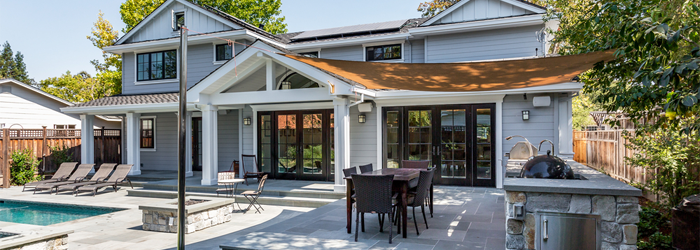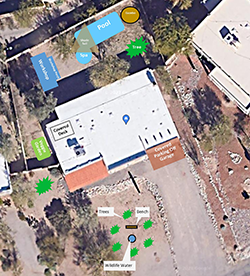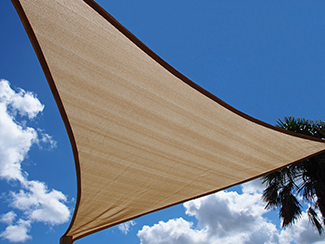Mapping Out Shade Zones
 29 June 2021
29 June 2021 

Mapping Out Shade Zones
In the summer do you drive around the parking lot for 20 minutes looking for a shady spot to park? The time it takes to find one can take as long as the errand would take itself. How about finding a shady spot at home? Where can you go to get some fresh air without being exposed to the direct sun?
Ole, Ole, Ole, Feeling Hot, Hot, Hot
Every year it seems a weather person does the tried-and-true cook-an-egg-on-the-sidewalk trick. A couple of years ago, Rosie took that test a bit further. No, he didn’t fry up bacon on the driveway to go with the egg; but he did take the temperature of various surfaces around the Romero home.
 The test took place at 2:00 p.m. when the outdoor temperature was 112 degrees in the direct sun (no shade). Rosie took the temperature with an infrared thermal imaging gun.
The test took place at 2:00 p.m. when the outdoor temperature was 112 degrees in the direct sun (no shade). Rosie took the temperature with an infrared thermal imaging gun.
Temperature Heat Test Results:
Note: Normal body temperature is 98.6 degrees fahrenheit. The below results are also in fahrenheit
- Green lawn: 102 degrees
- Gray troweled concrete: 128 degrees
- Travertine 136 degrees
- Flagstone, depending on the color: 144 to 152 degrees...the lighter the color, the cooler the temperature
- Saltillo tile: 145 degrees
- Concrete pavers: 146 degrees
- Trex composite decking: 150-175 degrees, depending on the color
- Natural redwood decking: 154 degrees
- Native Arizona soil: 156 degrees
- Slate: 163 degrees
- Black asphalt street: 176 degrees
Hot dang!! That’s hot! No wonder shade is at a premium!
Stick It Where the Sun DOES Shine
 You can spend time outside even in the heat of summer, providing you have adequate shade. Any shaded surface on a hot afternoon will be about 30 degrees cooler than in the direct sun. While you won't need a parka to sit in the shade, you will be considerably more comfortable.
You can spend time outside even in the heat of summer, providing you have adequate shade. Any shaded surface on a hot afternoon will be about 30 degrees cooler than in the direct sun. While you won't need a parka to sit in the shade, you will be considerably more comfortable.
Don’t go popping up a pergola, shade sails, or any other shade structure just yet. It is important to map out exactly where and how long the sun shines in the areas you want to sit or have an activity. Start by monitoring the areas outside of your house where you would like to spend time. If those areas see a lot of sunlight, then consider adding a shade structure. The next step is determining the kind of shade structure you want. There are many options such as:
- Pergolas / Gazebos
- Umbrellas
- Trees
- Shade Sails
- Extending the Roofline
- Doghouse / Pet Condo (with plenty of fresh water)
To map out shade and activity areas, take a Google screenshot of your house using Google Maps Satellite View and type in your address. Print the image of your house. Circle the areas you want shaded. Or take it a step further, as one of our staffers did, and digitally add the activities and shade areas. See her design on the right. Be mindful not to add so many structures that you block your view of the sunset, sunrise, or mountains.
Creating shade can be as simple as strategically planting a tree on the south or west side of the home. Not only will a tree (or any other shade structure) keep you cool outside, it reduces the amount of energy it takes to cool your house down. Before planting, consider the mature size of the tree. Plant far enough from the home so the roots will not interfere with the foundation. Caution: branches overhanging the roof can cause damage to the roof and provide a highway for critters to get on the house and into the attic. Read more about planting trees near your home.
Rosie recommends that before you spend money on anything to save money on your electric bill, consider ways you can shade your home. Shade can lower the temperature of the surfaces and the ambient temperature of the air by 15 or 20 degrees.
 These are some examples of the difference shade can make at Rosie's house when the temp was 110 degrees:
These are some examples of the difference shade can make at Rosie's house when the temp was 110 degrees:
- A west-facing wall in full exposure to the sun: 150 degrees
- That same wall with the same orientation but under the shade of a patio: 104 degrees
- The concrete tile floor of a west-facing patio: 123 degrees
- The same concrete tile floor behind a pull down shade screen: 96 degrees
- The tiff lawn in the backyard: 100 degrees
- The same lawn under the shade of Oleanders: 88 degrees
Shade sails continue to be very popular. Rosie cautions that installing shade sails is NOT a DIY project and should be designed by a licensed structural engineer. If they are bolted to a fascia, they can rip the entire fascia off the house in the event of high winds. If poles are used to support a sail, they require substantial footings to keep them from being pulled out of the ground in high winds.
While you are mapping your shade options, consider adding a misting system and/or a ceiling fan to reduce the temperature even further.
Special note about pets: Make sure your pets have adequate shade too. And if you won’t walk on a hot surface barefoot, don’t make your pets do it. If you must take them for a walk when it is hot, be sure to put booties on their paws and feet to prevent burns.
###
Podcast
A Fourth Of July Special: Two of Rosie On The House staff members tell their story of escaping their home country risking everything to come to America. Joanna Lawson's parents escaped Poland's martial law and Sefora Onye escaped communist rule in Romania.
Plus we cover our main home topic: mapping out shade zones to create cool spaces outdoors. We also talk to a listener who designed a wine cellar to look like a mine shaft!
Photo Credit
- Susan Kregar | Rosie on the House
- Shutterstock
Related Content
- Certified Partner: Booth Built Patio Products
- Blog: It’s Time To Add A Little Shade To Your Life
- Blog: Add More Shade To Your Outdoor Living Room
- DIY FAQ: Enjoy The Summer In The Shade
- DIY FAQ: How Can I Make My Back Yard More Comfortable During The Summer?
- DIY FAQ: What Is A Misting System?
- DIY FAQ: Tree Of The Month: Palo Brea Tree
- DIY FAQ: Tree Of The Month: Carob Tree
- DIY FAQ: How Close Can I Plant Trees To My Home?
Print this page
recent post
- Duck, Duck, Duct! How Often Should Ductwork Be Cleaned?
- Vinyl vs. Fiberglass Windows: Which Is The Better Choice Of Replacement Window?
- We May Be The Grand Canyon State, But The Rocky Mountains Are Important For Arizona
- Welcome to Arizona! Things A Newbie to Arizona Should Know
- The Pros & Cons of Buying A Flipped House
- Getting In On The Ground Floor
- Why It’s More Critical Than Ever To Get Your AC Serviced Before Summer
- The Reality of Remodeling
- What To Look For When Comparing Your Roofing Quotes
- What To Expect When Buying New Windows & Doors
